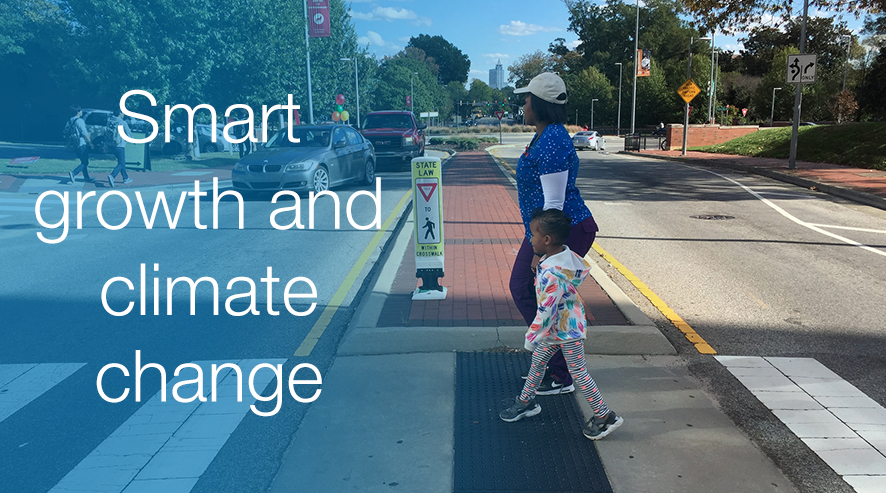
News
By Steve Davis, July 2, 2020
The House Select Committee on Climate Change released a new legislative blueprint this week for tackling the climate crisis that incorporates many of SGA’s recommendations across our programs, demonstrating how smart growth is at the core of any potential plan to reduce emissions.

Our climate crisis is deeply interconnected with the issues Smart Growth America has worked on for years: The lack of affordable housing in locations where transportation costs are low, the skyrocketing number of people struck and killed while walking, too much money for new roads while repair needs are neglected, and an overall system of land use and transportation that has sent emissions far past dangerous levels, to name a few. All of which are tied to a history of racism where benefits (and harms) do not accrue evenly.
We are living with the consequences of failing to address these issues for decades. Car-ownership is a prerequisite for participating in the economy in most communities, and many people drive further every year to reach work and daily necessities because it’s unsafe, inconvenient, or impossible by any other means. As a result, transportation is now the nation’s single largest source of greenhouse gases (GHG), accounting for 29 percent of emissions, and 83 percent of those emissions come from driving. While transportation rightly gets a lot of the focus, it’s not just transportation policy “driving” this outcome. Land use, transportation, housing, racial equity, economic development—they’re all connected, and we need legislative policy that takes a holistic and interconnected approach to solving these challenges
The good news is that the policies which support thriving communities for all are essential to reducing greenhouse gas emissions, which is illustrated in a new report issued this week, Solving the Climate Crisis: The Congressional Action Plan for a Clean Energy Economy and a Healthy, Resilient, and Just America. The committee’s action plan establishes a goal of reaching net-zero greenhouse gas emissions in the United States by no later than 2050, and net-negative emissions during the second half of the century. (See note above clarifying these targets with a third party evaluation saying actual reductions from the plan would be less.) It includes many specific recommendations that we offered to the committee staff and lays out a clear path for a holistic federal response to climate change.
 “This is the kind of bold but multifaceted plan that we’ll need to tackle the climate crisis and prioritize aid for those Americans most vulnerable to the negative impacts of climate change,” said SGA President & CEO Calvin Gladney. “There’s no one solution to climate change, and we will only reach our targets if we start to unwind all the many ways that current federal policy incentivizes sprawl, increases emissions, and accelerates inequities, and then propose new, more holistic paradigms that will lead us to a more equitable and climate resilient future.”
“This is the kind of bold but multifaceted plan that we’ll need to tackle the climate crisis and prioritize aid for those Americans most vulnerable to the negative impacts of climate change,” said SGA President & CEO Calvin Gladney. “There’s no one solution to climate change, and we will only reach our targets if we start to unwind all the many ways that current federal policy incentivizes sprawl, increases emissions, and accelerates inequities, and then propose new, more holistic paradigms that will lead us to a more equitable and climate resilient future.”
So how are we going to get to those ambitious targets? Here are four ways the committee has adopted a smart growth approach to solving the climate crisis, including many specific recommendations that we offered to the committee staff.
Lower emissions by building more homes people can afford near more transit
Housing and transportation are inextricably linked, and the best kind of affordable housing is in places with good access to lots of jobs and services via a range of low-cost (and low-emission) transportation options—like public transportation. The Committee demonstrates a good grasp of this concept (p.109):
The United States is facing a housing affordability crisis, particularly in its urban areas as more people move to cities in search of economic opportunities. At the same time, construction of affordable housing in these areas has fallen, often due to zoning restrictions and neighborhood opposition, causing demand to far outstrip supply. The result is rising housing costs in urban centers and displacement of low-income communities and communities of color to more suburban areas, where public transit options may be scarce or insufficient. Housing policy becomes climate policy when it limits households to one choice—cars—to commute and access services.
But they also understand the implications—it’s not as simple as only building more housing near transit:
Experience in cities across the country, however, shows that development near transit does not always help low-income households—those who are least likely to own cars and would benefit the most from transit access. Unless cities force inclusion of affordable housing and factor in equity concerns, developers gravitate toward higher-rent options, such as luxury condos and retail space.
 “You can deploy two basic strategies to get more attainable housing near transit: build a lot more transit, or build a lot more attainable housing near transit,” said Christopher Coes, vice president for land use and development at SGA. “The Select Committee rightly opts for both strategies. They recommend doubling transit capital funding to expand transit service, prioritizing projects that improve service and produce more affordable and market-rate housing, and following the INVEST Act’s move to establish an Office of Transit-Supportive Communities ‘to make grants, provide technical assistance, coordinate transit-housing policies across the federal government, and promote equitable development across the country.’”
“You can deploy two basic strategies to get more attainable housing near transit: build a lot more transit, or build a lot more attainable housing near transit,” said Christopher Coes, vice president for land use and development at SGA. “The Select Committee rightly opts for both strategies. They recommend doubling transit capital funding to expand transit service, prioritizing projects that improve service and produce more affordable and market-rate housing, and following the INVEST Act’s move to establish an Office of Transit-Supportive Communities ‘to make grants, provide technical assistance, coordinate transit-housing policies across the federal government, and promote equitable development across the country.’”
Meeting the incredible demand for more housing in locations where people can replace high-emission trips with shorter car trips, walking or biking trips, and transit trips is one of the best ways to reduce emissions—while also addressing the crisis of affordable housing that we face, if done right.
Lower emissions by measuring them (and other things that matter)
 “Transportation is the single largest source of carbon pollution in the U.S. in part because federal transportation policy has long prioritized high-speed, long-distance car travel at the expense of cleaner and more affordable transportation options as well as shorter or shared car trips,” said Beth Osborne, the director of Transportation for America. “This climate action plan would dramatically change how we measure success in transportation to stop incentivizing transportation investments that contribute to catastrophic climate change.”
“Transportation is the single largest source of carbon pollution in the U.S. in part because federal transportation policy has long prioritized high-speed, long-distance car travel at the expense of cleaner and more affordable transportation options as well as shorter or shared car trips,” said Beth Osborne, the director of Transportation for America. “This climate action plan would dramatically change how we measure success in transportation to stop incentivizing transportation investments that contribute to catastrophic climate change.”
Similar to the INVEST Act transportation bill being considered by the House this week, this plan recommends creating a new performance measure for greenhouse gas emissions, requiring states and metro areas to measure emissions and then create plans for lowering them. This seems like a subtle change but it is hard to overstate the impact. It gets a lot harder to justify building a new highway (that you probably can’t afford to maintain anyway) when you have to reduce emissions with your federal dollars, considering that every one-percent increase in lane miles results in a one-percent increase in vehicle miles traveled.
The plan also adopted T4America’s core priority to start measuring access to destinations, directing states and MPOs to start evaluating how well the transportation system facilitates access to housing, jobs, and critical services by any and all modes—similar to provisions that were included in the INVEST Act. Measuring access (instead of just vehicle speed) is already a more just way to evaluate transportation spending, but the plan also directs agencies to look at how access might differ for low-income communities and communities of color.
Lower emissions by prioritizing everyone’s safety instead of just those driving
The Committee makes numerous recommendations throughout the plan to prioritize funding for low-carbon transportation, especially walking and biking. The plan says Congress should update and boost funding for the Transportation Alternatives Program—which was doubled in the INVEST Act but is still just a paltry $1.5 billion per year for the entire country—as well as for other programs that make streets safer and more welcoming for bicyclists, pedestrians, and other vulnerable users.
 “Almost every trip begins or ends with a trip on foot, and too many trips that could be an easy walk, bike, or roll become a car trip because of a system that prioritizes moving cars quickly at all costs, resulting in streets that are ‘dangerous by design,’” said Emiko Atherton, director of the National Complete Streets Coalition.
“Almost every trip begins or ends with a trip on foot, and too many trips that could be an easy walk, bike, or roll become a car trip because of a system that prioritizes moving cars quickly at all costs, resulting in streets that are ‘dangerous by design,’” said Emiko Atherton, director of the National Complete Streets Coalition.
The access performance measure, noted above, starts to unwind some of this and improve safety. But the plan also recommends requiring states to use “complete streets” and context-sensitive principles, using language that actually comes directly from that long letter of recommendations that SGA and T4America sent to the Committee:
The current transportation system prioritizes vehicle traffic often at the expense of travelers using other forms of transport, including biking and walking. In many communities, walking or biking short distances may not be safe or even possible, as people must cross major roadways to reach their destinations. In contrast, communities with a “complete streets” program “direct their transportation planners and engineers to routinely design and operate the entire right of way to enable safe access for all users, regardless of age, ability, or mode of transportation.
Lower emissions by always fixing it first
The best strategy for lowering emissions is almost always prioritizing the repair and rehabilitation of existing assets before building something new—regardless of whether the new construction projects are transit systems, roads and bridges, older buildings, water systems, or almost any other type of infrastructure. Considering the fact that the federal government hands out $50 billion a year in transportation dollars that states can use in almost any way, requiring them to start prioritizing taking care of what they’ve already built before getting to build new roads or bridges is a great place to start. (Transit project sponsors are already required to prove they can afford to maintain any new capital project within the transit program.)
On page 105, the Committee cites our Repair Priorities report as they issue a recommendation to make “fix it first” the core function of federal transportation dollars:
Congress should direct states to prioritize maintaining and improving existing infrastructure and bringing it up to a state of good repair, including roads, bridges, and tunnels, rather than prioritizing new roads or lanes. Congress should set higher thresholds or criteria for funding of new roadway capacity projects, such as well-defined progress in achieving a state of good repair and meeting certain performance metrics, and ensure states have a financial plan to maintain the new roadway, lanes, or other infrastructure.
This “fix it first” smart growth approach applies to existing buildings too. There are millions of buildings sitting fallow or underused that just need some support to be rehabilitated. The plan also recommends expanding and increasing rehabilitation tax credits to “incentivize the reuse of existing building structures when developing new buildings that minimizes the need for new construction materials and reduces emissions.” In addition, the plan seems to give a nod to our REHAB tax credit proposal, mentioning credits for non-historic buildings of a certain age, though under the REHAB Act, those buildings would also need to be located near transit as well— one way to improve this recommendation from the committee.
**
The Select Committee deserves a lot of credit for a comprehensive action plan that recognizes how land use, transportation, and housing are all inextricably connected to climate change, and offers a unified proposal to tackle them all at once. We applaud their efforts here, and thank them for their willingness to listen to our suggestions and incorporate them into this plan.

© 2025 Smart Growth America. All rights reserved
Site By3Lane Marketing







